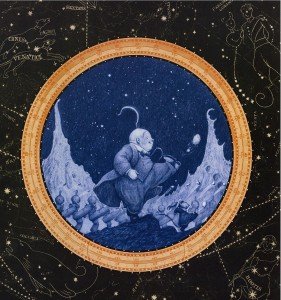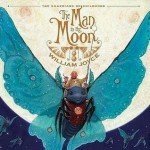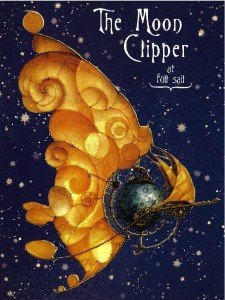Santa Claus, the Tooth Fairy, the Sandman, the Easter Bunny, Jack Frost and the Man in the Moon. What do they all have in common? Well, other than varying degrees of commercial value, nothing, other than they are the mythological beings of our childhood, along with (if you’re Canadian) the Friendly Giant and Mr Dressup. As such, they loom large in the imaginations of many children, and a certain, brilliant author and illustrator-William Joyce. The Man in the Moon is the first in a series of books to be called The Guardians of Childhood, a concept born out of Joyce’s disappointment at the ‘weak and undefined’ mythology surrounding these fantastical beings. “There are defined mythologies for Batman and Superman, so why not a defined mythology for something we actually believed in as children?” Why not indeed, although I personally don’t recall being too concerned about where the purveyor of my Mr Fruit n’ Nut originated, other than his name was Easter Bunny. But, I may have been wrong about that…
In The Man in the Moon, we meet The Man as a boy, nicknamed the Little Man in the Moon, or MiM for short, by his friend Nightlight. MiM travels the Universe with his parents on the Moon Clipper, a ship that resembles one of those strangely beautiful deep sea creatures shimmering with bio-phosphorescence. At night, the ship is designed reconstruct itself into a moon, where it travels from one peaceful planet to another. Baby MiM is cared for by his parents and an unusual assortment of friends, including Nightlight, who sprinkles Dreamsand over MiM to keep him safe from nightmares, a giant glowworm, and the ever present Moonmice, all of whom, in any other hands, would have been unforgivably cutesy if not for Joyce’s prodigious skills as an illustrator and as a storyteller. The ‘Golden Age’ comes to an end as darkness enters the world via Pitch, the King of Nightmares. (I believe I have been visited by him myself on several occasions, especially after watching Criminal Minds.) Pitch seeks the one child who has never had a nightmare, and a spectacular celestial battle ensues. The fate of the little man in the moon, and all the Guardians of Childhood, is set into motion.
Earlier this year, in an effort to discover why William Joyce had seemingly stopped writing books, I came across a small article that said he had lost his daughter to an illness. I hesitate to say anything more about this because grief is personal and a blog is a public forum, but I can’t separate this tragic turn of events in the author’s own life from his story of a band of mythical beings charged with protecting children. “We will watch over the children of the earth, guide them safely from the ways of harm…” This is a darker William Joyce than we’ve seen before, narratively and artistically. MiM loses his parents and his best friend Nightlight, and is essentially orphaned on the Moon Clipper, which has sailed (for reasons of safety) to Earth, an ‘uncharted little green and blue planet with no moon.’ The scene of young MiM standing alone on the surface of the now stationary ship, his head bald except for a curling attennae, is the most beautiful, stirring illustration in the book. Unlike most of Joyce’s work, this picture is startlingly monochromatic, painted in variations of twilight blue, giving diffuse shape to the wave-like moonscape and the chubby little figure of MiM.
Nevertheless, in spite of the darker subtext in The Man in the Moon, William Joyce brings his usual, or to be more specific, his unusual style and humour to the story. It is not just about guarding children, but childhood, and Joyce captures the boundless imagination of a kid with such exuberance it is downright cinematic. This is true of all of his books. As mentioned in my review of The Leaf Men and the Brave Good Bugs, Joyce ‘directs’ his books like a Preston Sturges 1930’s screwball comedy, with the addition of several swashbuckling action sequences. His stylistic allegiance to this era is in full display in the hilarious promotional video for the Guardians of Children. According to Joyce, although he had originally thought of this series when his daughter was born, it was his Uncle Art Aimsworth who discovered ‘…factual records of how these guys came to be in a grain silo on his farm in Abilene, Texas.’ Uh huh. I’m not going to argue the veracity of this statement; anything is possible in the Joycean universe.
specific, his unusual style and humour to the story. It is not just about guarding children, but childhood, and Joyce captures the boundless imagination of a kid with such exuberance it is downright cinematic. This is true of all of his books. As mentioned in my review of The Leaf Men and the Brave Good Bugs, Joyce ‘directs’ his books like a Preston Sturges 1930’s screwball comedy, with the addition of several swashbuckling action sequences. His stylistic allegiance to this era is in full display in the hilarious promotional video for the Guardians of Children. According to Joyce, although he had originally thought of this series when his daughter was born, it was his Uncle Art Aimsworth who discovered ‘…factual records of how these guys came to be in a grain silo on his farm in Abilene, Texas.’ Uh huh. I’m not going to argue the veracity of this statement; anything is possible in the Joycean universe.
So how does Santa Claus and the Easter Bunny end up in this story of The Man in the Moon? Without giving away too much of the plot, MiM uses his father’s telescope to observe Earth, and much to his delight discovers children, just like he used to be, and sets about finding ways to ‘…keep happy their hearts, brave their souls, and rosy their cheeks.’ It helps that he has friends in high places (as in the North Pole), and is privy to the secret fears and dreams of children via lost balloons that waft up to the moon, which MiM alone is able to ‘hear.’ The Guardians of Childhood is a grand undertaking by  William Joyce, encompassing picture books, novels, and a film. The Man in the Moon, the first in the series, is a beautiful, emotionally stirring, and wondrously imagined origin story, which not only introduces us to a small fellow dwelling on the moon, but promises many tall tales to come.
William Joyce, encompassing picture books, novels, and a film. The Man in the Moon, the first in the series, is a beautiful, emotionally stirring, and wondrously imagined origin story, which not only introduces us to a small fellow dwelling on the moon, but promises many tall tales to come.
Welcome back, Mr Joyce!
The Man in the Moon by William Joyce, published by Atheneum (Simon & Schuster), 2011. ISBN: 978-1442430419
Next in the series…Nicholas St North and the Battle of the Nightmare King (a chapter book), 2011. ISBN: 978-1442430486
Guardians of Childhood website



I too have felt the fear of Pitch as a child, particularly when I was the last one to turn off the basement lights before scrambling up the stairs.
Wow. What stunning illustrations. Can’t wait to read this one.